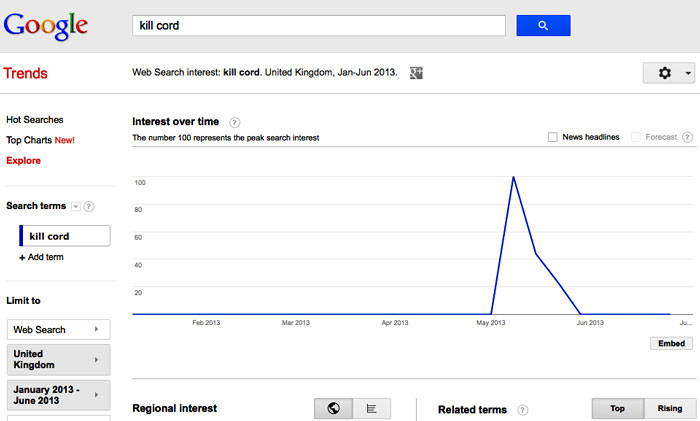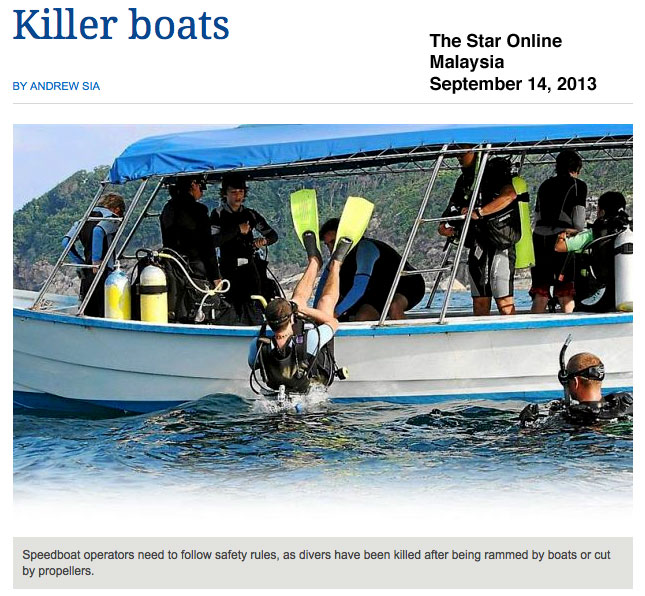The Media and Boat Propeller Safety
Media (television, printed, radio, online, movies, etc.) all have an impact on public perception of the danger of boat propellers, on the public’s awareness of steps to be taken to improve their safety, on public awareness of potential solutions, on public awareness of regulations and proposed regulations, and on the ability of both sides of the issue to make their points within the industry and to the public as a whole. This is true not only within the U.S., but across the world.
It is also important to recognize many different media segments impact boat propeller safety, including:
- Boating industry trade media – printed and online publications targeting those who work in the boating industry. Typically heavily funded by advertisements from those selling equipment or services to the boat building industry.
- Boating Media – printed and online publications targeting boaters. Typically heavily financed by advertisements from boat builders, marine drive manufacturers, and manufacturers of boating accessories.
- Lake Community News – hundreds of newsletters, small papers, and websites devoted to local news in on or near water communities.
- Visitor guides – often include road maps, lake maps, locations of local eateries, marina’s, bait shops, and sites to see. Typically heavily funded by local advertisers.
- Coast Guard, RYA, MAIB media – typically consists of regulatory or safety messages for the industry or for the public
- Legal, Court Reporting Media
- News media – the thousands of news outlets, newspapers, radio news, online news, etc. We typically watch these sources for reports of propeller accidents.
- Independent Investigative Media – several small firms perform in-depth investigative reporting of perceived “wrongs” and either publish them or try to sell them to mainstream media
- Propeller safety advocate media – websites and publications of those promoting boat propeller safety or cover issues relevant to boat propeller safety (such as ours). Some promote boating safety or rental boating safety in general.
- Social Media – sometimes includes coverage of propeller accidents, new products, safety messages, and historical materials
- Entertainment media – movies, music, art sometimes include propeller accidents or tributes to victims of propeller accidents
- Crowdsourcing Cause Media – places to get your propeller safety petition posted and signed on line
- Fundsourcing Media – sites to raise funds for propeller safety related causes or for financial assistance to those struck by propellers
We have written several articles on these topics in the past. This post will try to bring our previous posts on this topic together, and outline some of our plans for the future.
Brief Discussion of our Previous Coverage
- Vaccination – media coverage of high profile local propeller accidents can lead to temporary adaptation of safer boating behaviors. We posted several brief notes in on our Propeller Safety Thoughts Prior to June 2011 page. See entries for: 21-22 November 2007, 8 August 2007, 27 July 2007, 14-15 July 2007, and 11 July 2007. We also have a potential research project for Senior Design project Classes on vaccination on our Senior Design page.
We have reasonable coverage on this topic by it is very scattered and not easy to find. We may try to pull our scattered materials and some more recent findings together in the future.
- Media Coverage of Accidents Leads to National Discussion – strong national coverage of a boat propeller accident can lead to a national discussion on the issues. While we did not write specifically on that topic, it is easily seen in the wake of the May 2013 Milligan accident in the UK. A tremendous discussion was launched there on propeller safety in general, and more specifically on the use of kill cords /lanyard kill switches. That discussion is still reverberating. We created several posts related to those discussions. Many can be seen by clicking on “UK” in the “Tag” section on our vertical right panel on most pages of our site.
- Accident Statistics Misreported – the boating industry media and the mainstream media have a long history of reporting the wrong statistics for boat propeller accidents. We explain those problems in our USCG Propeller Accident Statistics: A Guide for Reporters and Other Media Representatives and vent about some examples at Propeller Accidents: Another Inconvenient Truth and another example at Stephen Keller Boat Propeller Accident – Boat Propeller Fatality Statistics Under Reported – San Jose Mercury News Misinforms Readers. When they misreport statistics, boaters and others on the water are not aware of their risk of propeller injury.
- Public Service Announcement – our coverage of the boating industry banning the U.S. Coast Guard Public Service Announcement (PSA), Don’t Wreck Your Summer. They banned it because they thought it showed boating in bad light, even though the video was directly in line with a recommendation of the 1989 Propeller Guard Subcommittee (which the industry often touts for not recommending the use of guards). The 1989 study recommended the Coast Guard include the potential hazards of negligent boat operation in educational and awareness campaigns, and that such programs should “be as vivid as possible in depicting underwater impact scenarios.”
- We covered PowerBoat & RIB, a UK magazine, and their distribution of an “Attach Your Kill Cord” sticker with their July 2013 issue. We mentioned how we could not envision a similar project in the U.S. due to industry control of the boating media.
- We dared the boating media to cover the Yamaha “coverup” of saying many positive statements about their new propeller guard, then erasing all evidence of its existence from their website after we called attention to their comments. The boating media failed to respond, even to this statement in bold font on the page linked to above, “We dare the boating industry trade press to cover this important story. Don’t let the industry banish this life saving propeller guard just to protect themselves in court.”
- We near live blogged the Listman trial for Courtroom View Network (CVN) showing the capabilities of live streamed courtroom video combined with blogging.
- We used a series of three posts and “wordles” to illustrate the change in coverage of a single boat propeller accident being covered by numerous media sources over time:
- We have done a little work with search engine counts, Google searches for “Kill Cord” spike in UK following the Milligan accident. We have also used Google Trends, Google Adwords search frequency counts, Wordles, and Google Ngrams. The low frequency of use of most terms and phrases related to boat propeller safety limit the use of some of these tools. We anticipate doing more work in this area in the future.
Future Project – Comparing U.S. media coverage of boat propeller accidents, with the quantity of coverage in other countries
We have made some quick comparisons of the quantity and level of coverage of boat propeller accidents in the U.S. vs. the UK and plan to enlarge those efforts. One opportunity is to analyze new media coverage of the Hutton (UK) and Gorzell (US) accidents. These two promising teenagers were fatally struck by boat propellers on opposite sides of the Atlantic at almost the same moment.
We have completed a very quick comparison of Hutton vs. Gorzell media coverage. We captured Google news article counts for the phrases “Charlie Hutton” and “Kali Gorzell” four days after the July 20, 2012 accidents (captured at 9:35 am our time, July 24, 2012).
Kali Gorzell (US) had 32 news articles, almost all of which were local to her San Antonio area, or scrubbers just copying their text.
Charlie Hutton (UK) had 321 news articles, many of which were in the national media.
321/31 = approximately ten times as many news articles in the UK. The actual penetration would be even much greater with the UK national media carrying countless stories and updates, vs the few regional stories in the U.S.
In recent times, the UK immediately flashes to national media coverage of specific propeller accidents, while the U.S. tends to cover similar accidents locally, or not at all. We have even seen some recent instances of the UK nationally covering U.S. boat accidents that were only regionally covered here (Mansour, Feehan).
We plan on further developing this comparison in the future.
Future Project – Analyzing tone, gore level, and other differences in media coverage of propeller accidents around the world
Different tones are quickly observable in the coverage in some countries. Some administrations seem to want to sweep them away and hide them, while their people want to complain about the risks of being in the water and no actions being taken. Others focus outside their country against those who may be insisting on changes to keep their tourists safer. Portions of Asia are known for particularly gory photos and headlines following propeller accidents. Charter businesses (dive, party, snorkel), especially those outside the U.S. tend to want to hide that an accident even took place.
We plan on developing some stories on the differences in media coverage by country in the future.
Our Message to the Media
We appreciate your coverage of boat propeller accidents, issues, events, and propeller safety devices. We ask that when you include boat propeller accident statistics from the U.S. Coast Guard that you make sure you report those statistics correctly. While we recognize that money talks, we encourage you to stand up to your advertisers and print the truth on issues important to public safety when appropriate.
Thanks again for all you efforts to make the public more aware of boat propeller accidents and the issues surrounding them.

